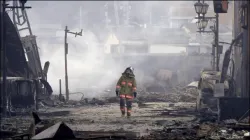Japan earthquakes: Death count rises to 64 as survivors face freezing rain, possible landslides
Heavy rains were forecast in the quake-hit areas on Wednesday raising fears of landslides, authorities said, which could further hinder efforts to free many more trapped under rubble. Access to the remote location of the hardest-hit areas has been complicated due to damaged infrastructure.

The death count in Japan rose to 64 on Wednesday after at least 155 earthquakes rocked the country on New Year's Day as rescue workers continued to search for people still feared trapped under the rubble in the midst of freezing temperatures and heavy rain forecast. Among the earthquakes was a powerful tremor of 7.6 magnitude, levelling houses and cutting areas from much-needed aid.
Heavy rains were forecast in the quake-hit areas on Wednesday raising fears of landslides, authorities said, which could further hinder efforts to free many more trapped under rubble. Severed roads, damaged infrastructure, and the remote location of the hardest-hit areas have complicated rescue efforts, and the full extent of damage and casualties remains unclear two days after the quake.
The first 72 hours are considered crucial to save lives after disasters. However, authorities in the town of Suzu which has just over 5,000 households have been unable to respond to 72 calls for help, said Mayor Masuhiro Izumiya.
The earthquake with a 7.6-preliminary magnitude destroyed several buildings, caused fires and knocked out power to tens of thousands of homes, prompting residents in some coastal areas to flee to higher ground. The Japan Meteorological Agency (JMA) initially issued a major tsunami warning - its first since the March 2011 earthquake and tsunami that struck northeast Japan killing nearly 20,000 people - for Ishikawa prefecture
What did PM Kishida say?
"It's been over 40 hours since the initial quake. This is a battle against time, and I believe now is a crucial moment in that battle," Japanese Prime Minister Fumio Kishida said after a disaster response meeting on Wednesday. His government opened a sea route to deliver aid and some larger trucks are now able to reach the areas most affected by the quake, he added.
Meanwhile, smaller aftershocks continued to strike the peninsula as firefighters searching for survivors in the rubble of a partially collapsed building were seen rushing out to safety as an earthquake warning alarm sounded before noon on Wednesday.
Of the deaths, 29 were counted in Wajima city, while 22 people died in Suzu, according to Ishikawa Prefectural authorities. Dozens of people have been seriously injured, including in nearby prefectures. However, some of the damage appears to have been limited by prompt public warnings and quick response from civilians and officials.
Toshitaka Katada, a University of Tokyo professor specializing in disasters, said people were prepared because the area had been hit by quakes in recent years. They had evacuation plans and emergency supplies in stock.
It was the strongest quake in the region in more than four decades, according to the US Geological Survey as army personnel were deployed to assist with rescue operations. The tremor was also felt in the mountains of neighbouring Nagano prefecture.
The Japanese government said that as of Monday night, it had ordered around 100,000 people in nine prefectures on the western coast of Japan's main island Honshu to evacuate. They were set to spend the night in sports halls and school gymnasiums, commonly used as evacuation centres in emergencies.
Earthquakes in Japan
Earthquakes are common in Japan, one of the world's most seismically active areas. The island nation sits on the so-called Pacific “Ring of Fire"-- a term coined to refer to the Circum-Pacific Belt. Simply put-- it is a path along the Pacific Ocean characterised by active volcanoes and frequent earthquakes. According to scientists, the majority of Earth’s volcanoes and earthquakes take place along the "Ring of Fire".
The country has a history of deadly earthquakes wherein lakhs of people were killed in the past century. Similar figures also witnessed serious injuries. A magnitude 9.0 quake on March 11, 2011, off Japan’s northeastern coast, triggered a massive tsunami, killed roughly 20,000 and triggered a nuclear disaster.
(with inputs from agencies)
ALSO READ | Japan Airlines plane crash: How did officials pull off miraculous escape of 379 passengers?